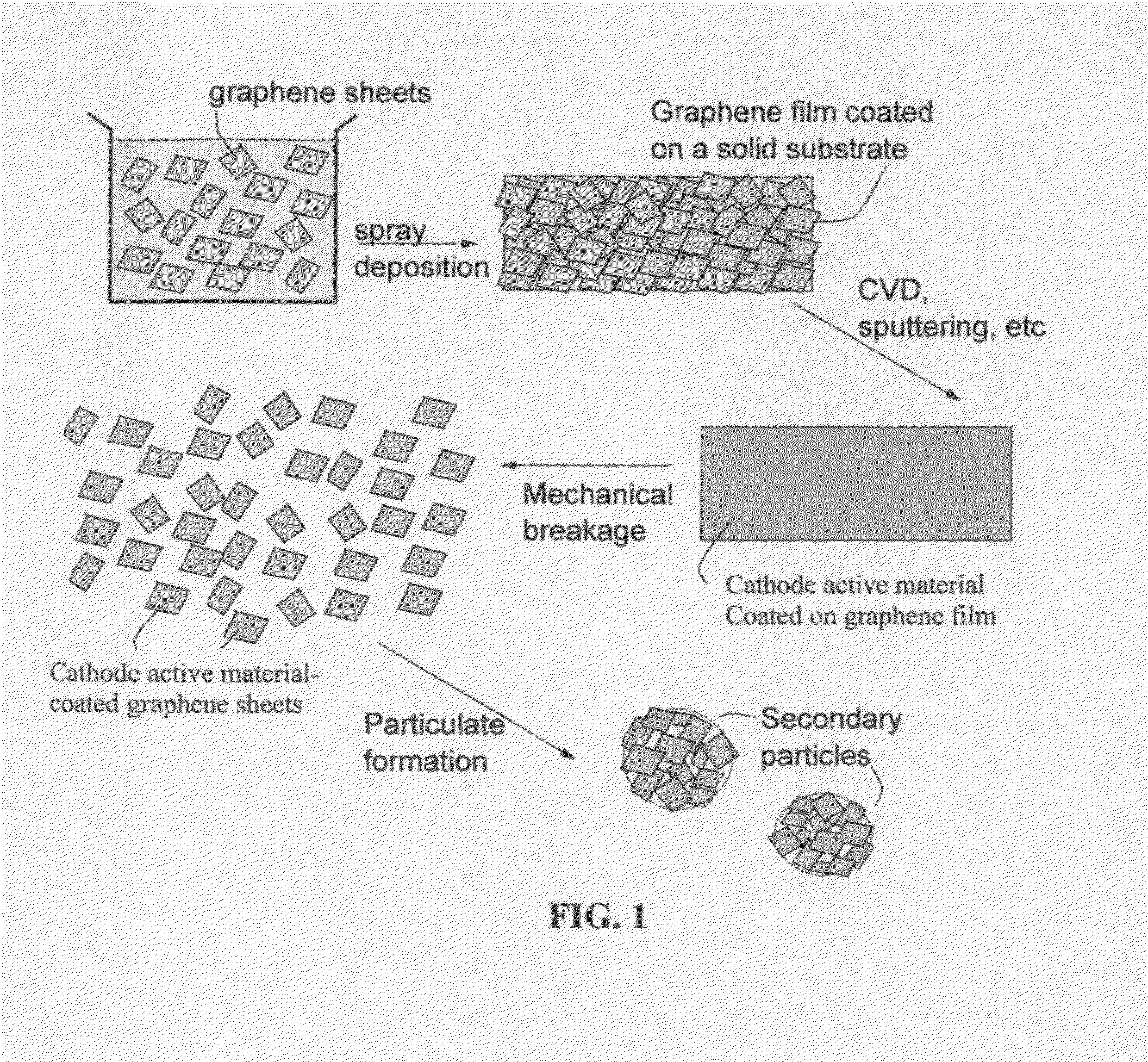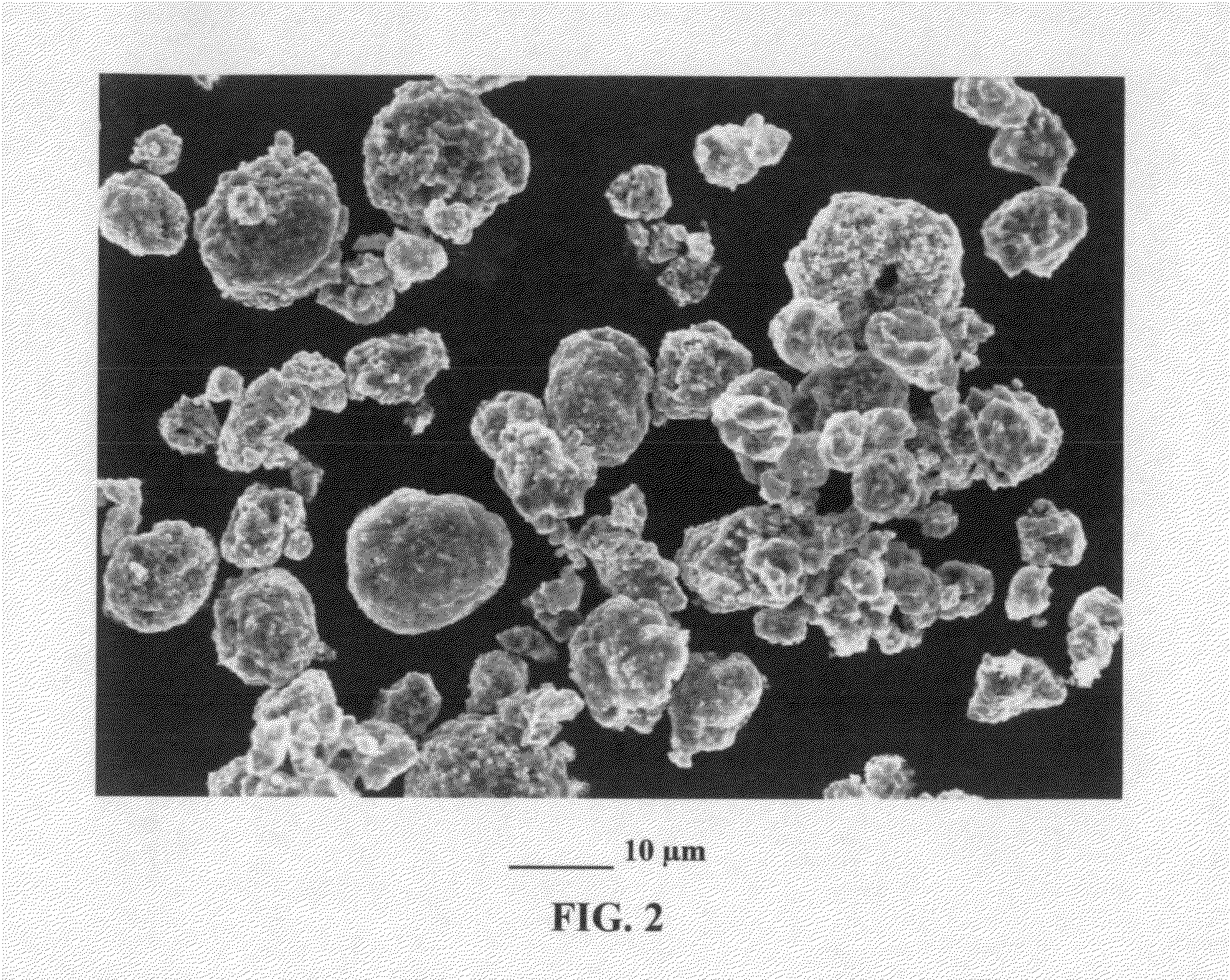Cathode active material-coated discrete graphene sheets for lithium batteries and process for producing same
- Summary
- Abstract
- Description
- Claims
- Application Information
AI Technical Summary
Benefits of technology
Problems solved by technology
Method used
Image
Examples
example 1
Graphene Oxide from Sulfuric Acid Intercalation and Exfoliation of MCMBs
[0122]MCMB 2528 meso-carbon microbeads were supplied by Alumina Trading, which was the U.S. distributor for the supplier, Osaka Gas Chemical Company of Japan. This material has a density of about 2.24 g / cm3 with a median particle size of about 22.5. MCMB 2528 (10 grams) were intercalated with an acid solution (sulfuric acid, nitric acid, and potassium permanganate at a ratio of 4:1:0.05) for 48 hours. Upon completion of the reaction, the mixture was poured into deionized water and filtered. The intercalated MCMBs were repeatedly washed in a 5% solution of HCl to remove most of the sulphate ions. The sample was then washed repeatedly with deionized water until the pH of the filtrate was neutral. The slurry was dried and stored in a vacuum oven at 60° C. for 24 hours. The dried powder sample was placed in a quartz tube and inserted into a horizontal tube furnace pre-set at a desired temperature, 800° C. for 30 sec...
example 2
Oxidation and Exfoliation of Natural Graphite
[0123]Graphite oxide was prepared by oxidation of graphite flakes with sulfuric acid, sodium nitrate, and potassium permanganate at a ratio of 4:1:0.05 at 30° C. for 48 hours, according to the method of Hummers [U.S. Pat. No. 2,798,878, Jul. 9, 1957]. Upon completion of the reaction, the mixture was poured into deionized water and filtered. The sample was then washed with 5% HCl solution to remove most of the sulfate ions and residual salt and then repeatedly rinsed with deionized water until the pH of the filtrate was approximately 7. The intent was to remove all sulfuric and nitric acid residue out of graphite interstices. The slurry was dried and stored in a vacuum oven at 60° C. for 24 hours.
[0124]The dried, intercalated (oxidized) compound was exfoliated by placing the sample in a quartz tube that was inserted into a horizontal tube furnace pre-set at 1,050° C. to obtain highly exfoliated graphite. The exfoliated graphite was dispers...
example 3
Preparation of Cathode Active Material-Coated Graphene Sheets and Secondary Particles
[0125]Continuous graphene films coated with a cathode active material were prepared from sputtering (e.g. lithium metal oxide), physical vapor deposition (e.g. S), and solution deposition. The coated film was broken, cut into pieces, and then air jet milled to obtain small pieces of active material-coated graphene sheets.
[0126]For the preparation of graphene-enhanced particulates, an amount of a selected electrode active material powder (control sample, no supporting graphene sheet) or active material-coated graphene sheets was added to a desired amount of GO suspension to form a precursor mixture suspension with a solid content of approximately 10% by weight. After thorough mixing in an ultrasonication reactor, the suspension was then spray-dried to form the graphene-enhanced secondary particles (particulates). The cathode active materials studied in this example include lithium cobalt oxide, lithi...
PUM
| Property | Measurement | Unit |
|---|---|---|
| Fraction | aaaaa | aaaaa |
| Fraction | aaaaa | aaaaa |
| Fraction | aaaaa | aaaaa |
Abstract
Description
Claims
Application Information
 Login to View More
Login to View More - R&D
- Intellectual Property
- Life Sciences
- Materials
- Tech Scout
- Unparalleled Data Quality
- Higher Quality Content
- 60% Fewer Hallucinations
Browse by: Latest US Patents, China's latest patents, Technical Efficacy Thesaurus, Application Domain, Technology Topic, Popular Technical Reports.
© 2025 PatSnap. All rights reserved.Legal|Privacy policy|Modern Slavery Act Transparency Statement|Sitemap|About US| Contact US: help@patsnap.com



